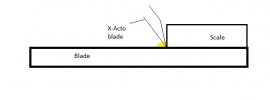- Joined
- Jun 3, 2019
- Messages
- 2,714
I recently glued up a handle onto a full tang blade (i.e. full flat tang, two scales, one on either side), and, after setting the blade down for the epoxy to cure, came back to find that there had been some seepage of epoxy out of the front line of the bolster, so there is a small filet of epoxy visible on the metal in front of the bolster. I did wipe off excess and clean the metal after clamping ... but this seepage occurred some time after that (first time this has happened to me :-( .
Now that the epoxy is fully cured, is there any reasonable way to remove this small amount of excess epoxy without destroying the finish of the blade?? There has been some discussion about using a brass "chisel" to remove solder .... but not sure if this will work with epoxy ... definitely so without scratching/marring the front of the bolster???????
Now that the epoxy is fully cured, is there any reasonable way to remove this small amount of excess epoxy without destroying the finish of the blade?? There has been some discussion about using a brass "chisel" to remove solder .... but not sure if this will work with epoxy ... definitely so without scratching/marring the front of the bolster???????

